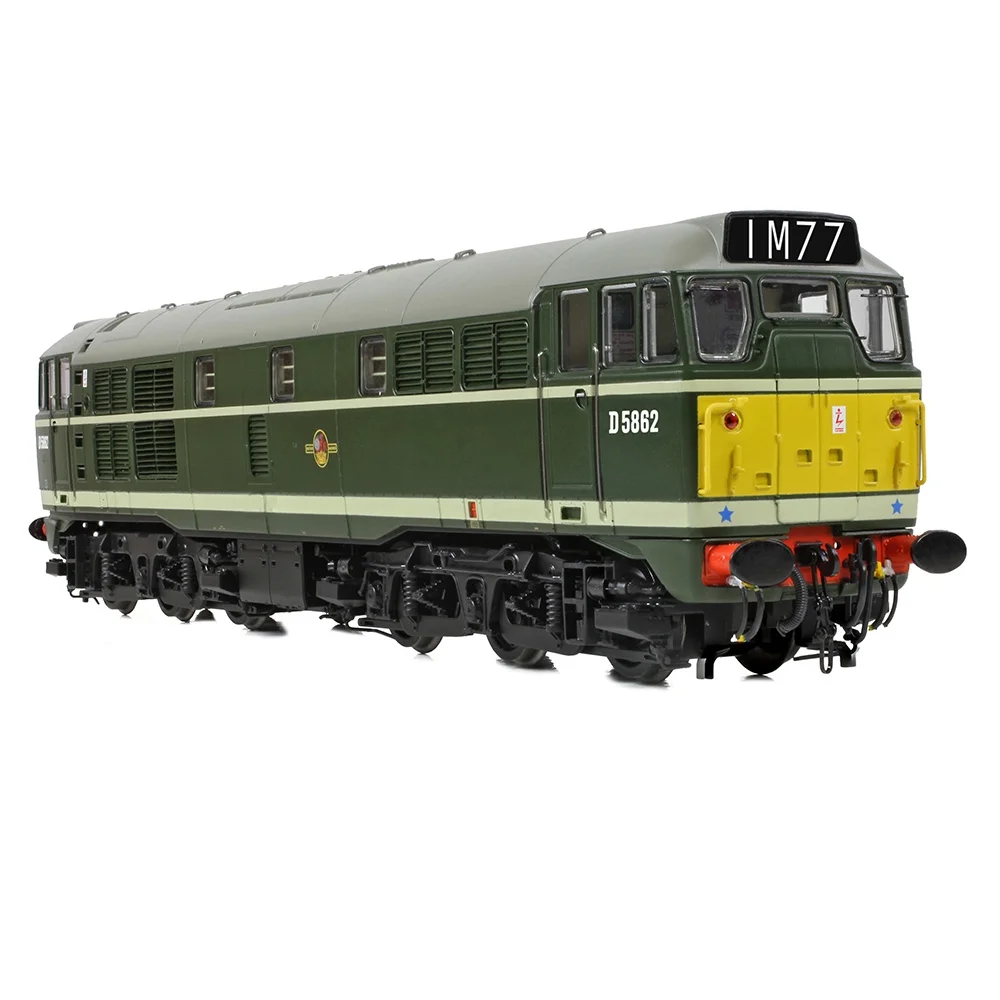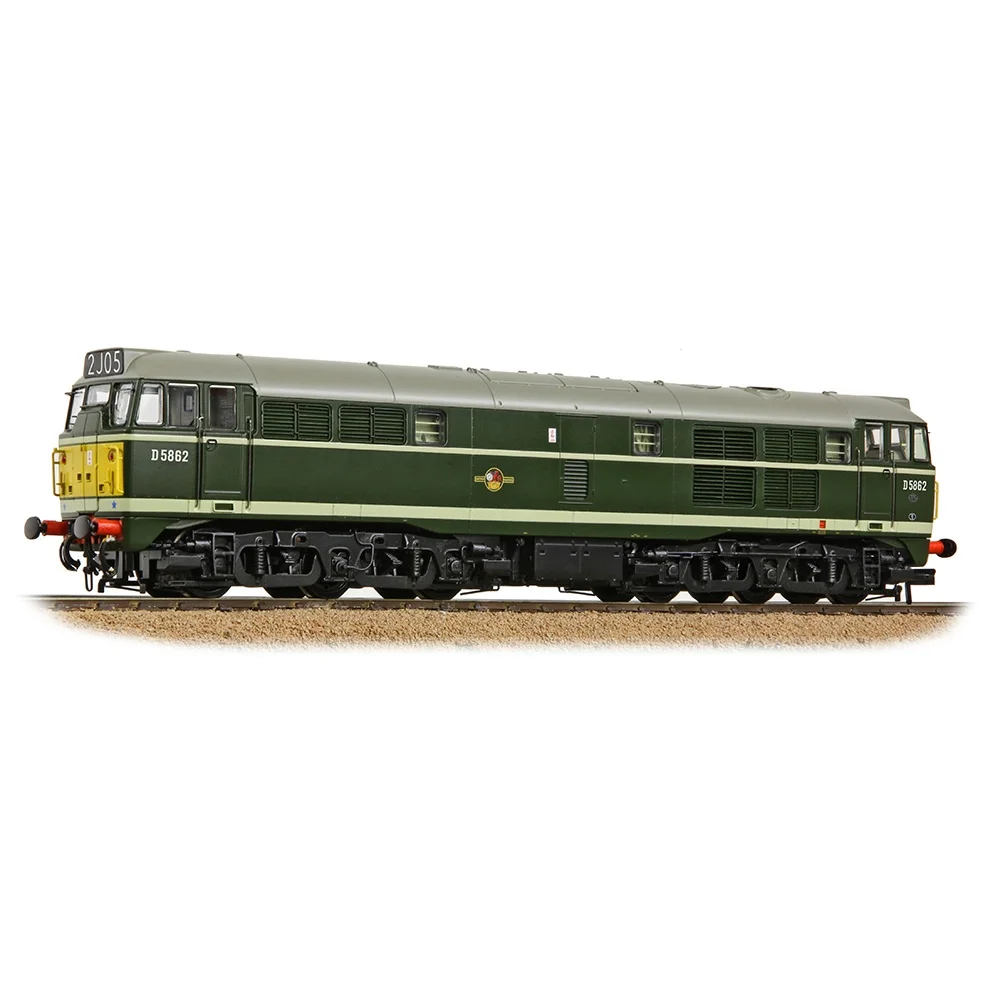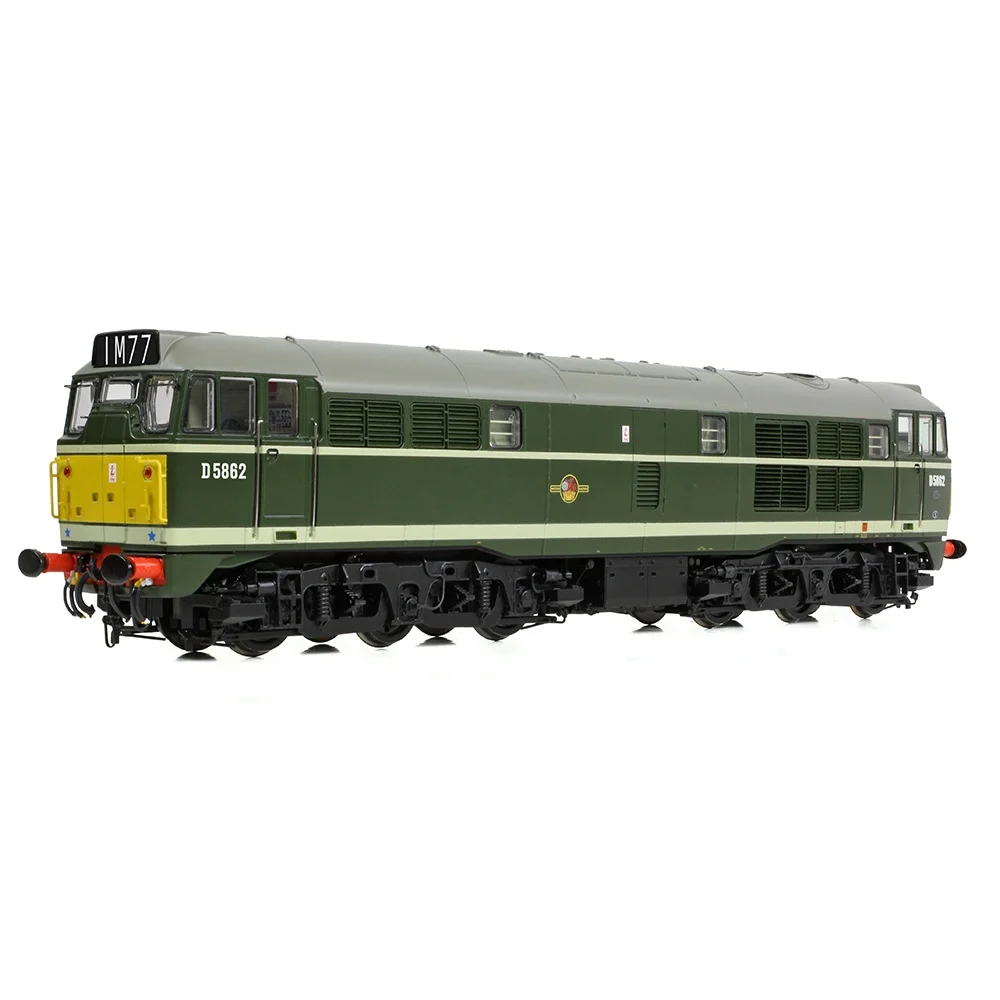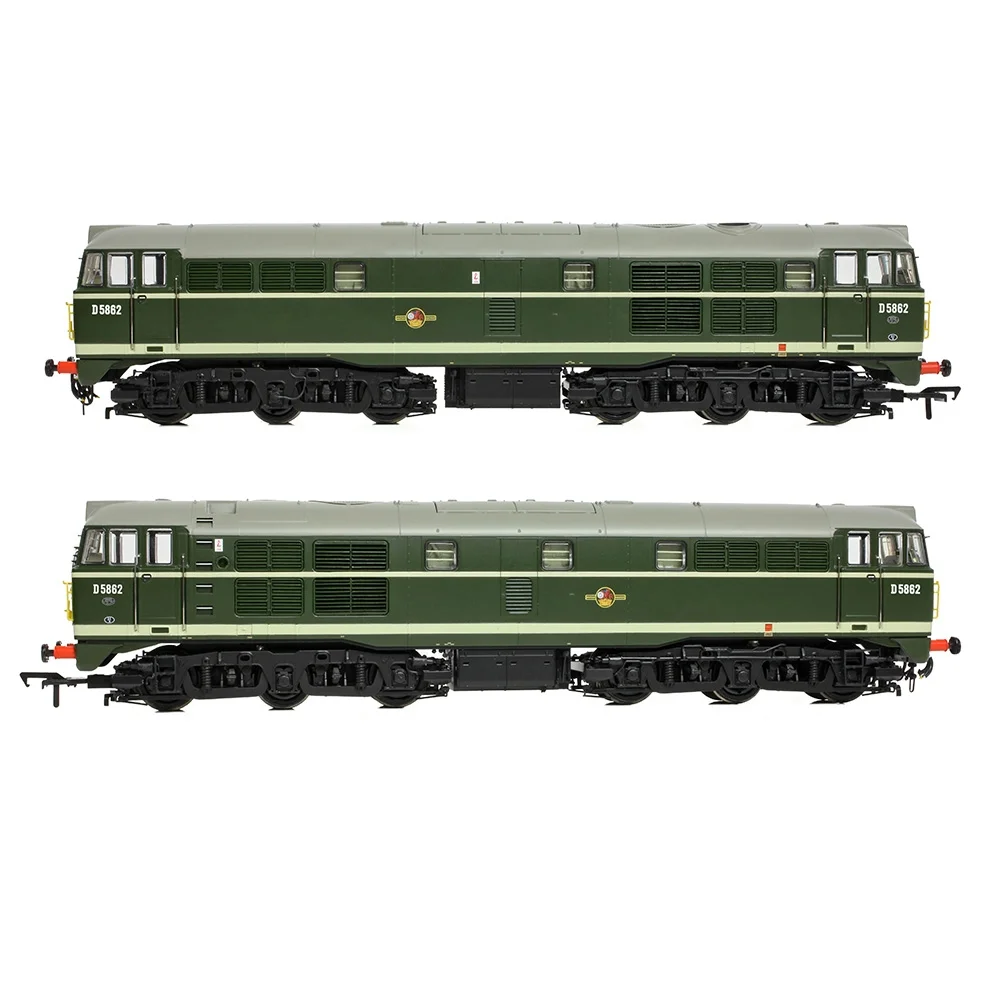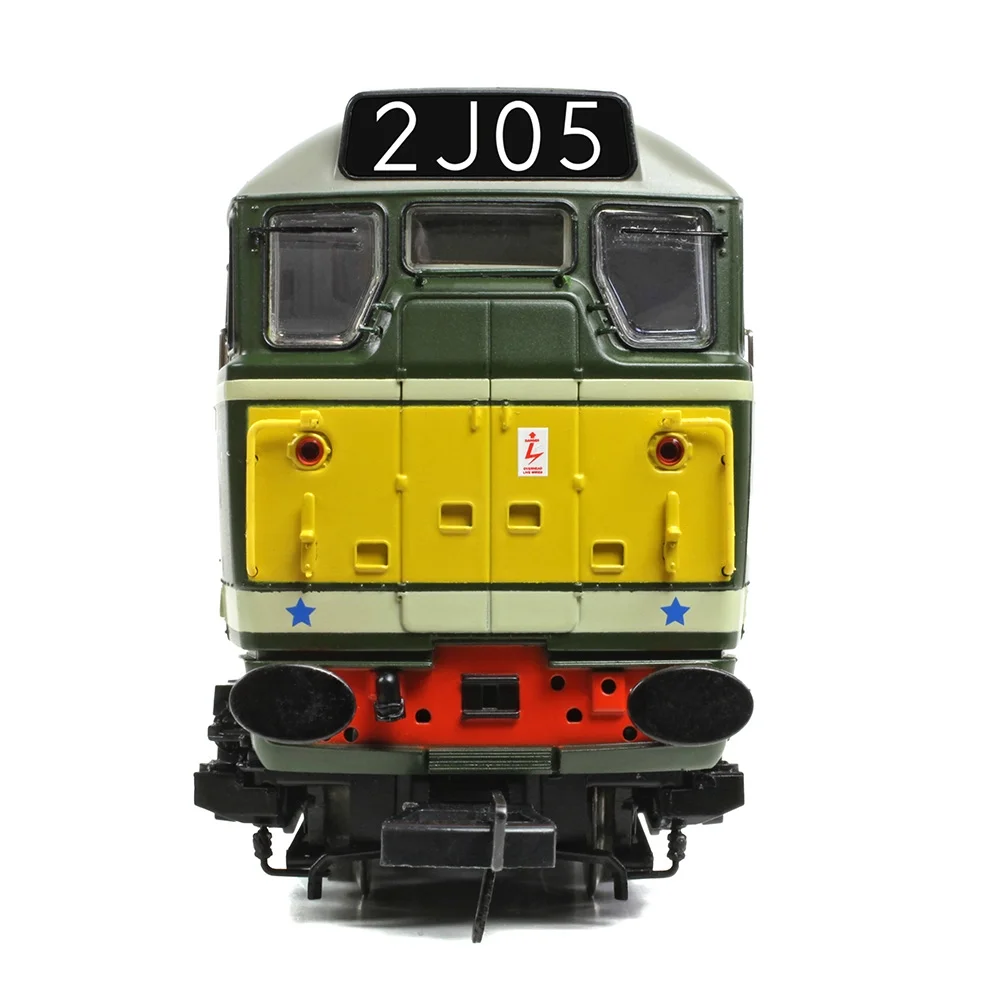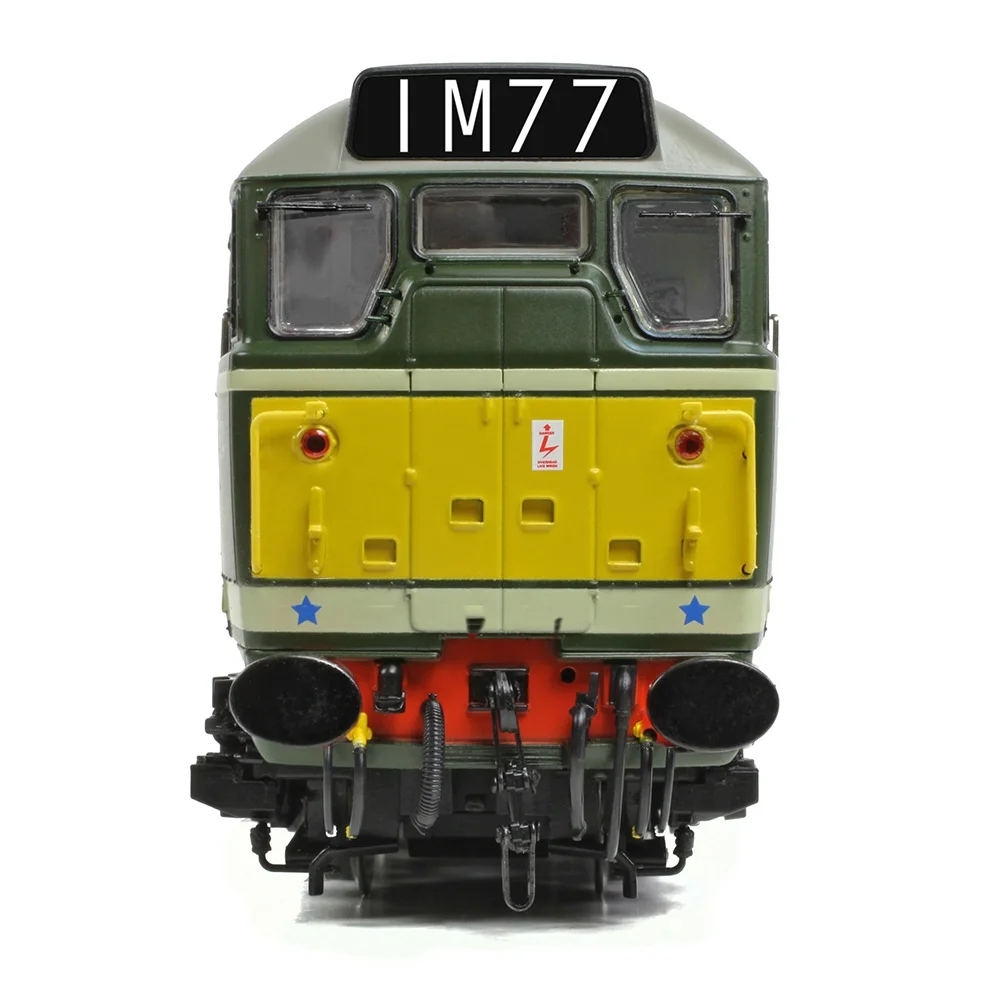Bachmann 35-802A
British Rail Class 30 D5862 British Railways Green with Small Yellow Panels
Bachmann's Description & Specifications
The Brush Type Twos – Class 30s and Class 31s – by Bachmann Branchline are back and better than ever, now featuring a Bach-Up Stay Alive System fitted as standard and all-wheel electrical pickup assuring the smooth and powerful performance you’ve come to expect from Bachmann Branchline models.
With high fidelity mouldings, numerous separately fitted parts and countless tooling variations to capture the minutiae of the real locomotives throughout their lives, our new Class 30 is brought to life with an exquisite livery application using true-to-prototype colours, fonts and logos. Along with an unprecedented array of lighting features, our Dual Fitted speaker system is fitted to all models – bringing to life our SOUND FITTED models. For the ultimate experience, choose one of our SOUND FITTED DELUXE models with their motorised radiator fan, authentic tinted windscreen glazing and hands-free DCC-uncoupling thanks to Bachmann’s revolutionary Auto-Release Coupling System!
Depicting a Class 30 in original condition, this locomotive was fitted with a Mirrlees engine and the Branchline model faithfully recreates this, with the correct roof exhaust ports and Mirrlees engine block detail visible through the bodyside windows.
- Bachmann Branchline OO Scale
- Era 5
- Locomotive is now Preserved
- Pristine BR Green (Small Yellow Panels) livery
- Running No. D5862
- Equipped with a Plux22 DCC Decoder Socket - recommended Decoder item No. 36-570B
- Length 228mm
DETAIL VARIATIONS SPECIFIC TO THIS MODEL
- Original Body
- Original Gangway Doors
- Glazed Headcode Panels - displaying Blinds 2J05 and 1M77
- Original Windscreen Washer Jets (Uncovered)
- Full Bufferbeam Cowling
- Original Windscreen
- Original Main Fan Grilles with Horizontal Fins
- Mirrlees Engine Exhaust Ports
- Mirrlees Engine Block Detail
- Original Open Boiler Port
- Original Water Filler Hatch
- Open Bodyside Steps
- Original Battery Boxes
BACHMANN BRANCHLINE CLASS 30/31 SPECIFICATION
MECHANISM:
- Five pole, twin shaft motor with two flywheels providing drive to both bogies
- All axle drive
- Electrical pickup from all wheels on each bogie
- Separate metal bearings fitted to each axle
- Diecast metal chassis block and bogie towers
- Diecast metal gearboxes, with gearing arranged for prototypical running speeds and haulage capabilities
- 16.5mm (OO gauge) wheels to NEM310 & NEM311 standards with authentic profile and detailing
- Detachable coupling pockets to NEM362 standards fitted to each bogie
- Auto-Release Couplings fitted at both ends – DCC operated, hands-free uncoupling with the press of a function button (SOUND FITTED DELUXE models only)
- Designed to operate on curves of second radius (438mm) or greater
DETAILING:
- Bogies constructed from multiple components featuring full relief detail
- Rotating radiator fan, driven by an independent motor and gearbox, operated as part of the sound project on DCC and Analogue control (SOUND FITTED DELUXE models only)
- Tinted windscreen glazing (Driver and Second Man windscreens only as per the prototype, SOUND FITTED DELUXE models only)
- Separately applied metal detail parts, including grab handles, windscreen wipers and etched fan grilles
- Sprung metal buffers
- Each model supplied with a full set of decorated, model-specific bufferbeam pipework and accessory parts including three-piece, body-mounted snow ploughs
LIGHTING:
- Directional lighting, including illuminated headcode panels and high intensity headlights where applicable, switchable on/off at either end on DCC or Analogue control
- Cab lighting*, assigned to two DCC functions for separate switching of each
- Separately switched Engine Room lighting*
- Single or twin red tail lights* (*when used on DCC)
- Authentic light colours and temperatures selected for each model based on era and application
DCC:
- Plux22 DCC decoder interface
- Bach-Up Stay Alive Systemproviding uninterrupted power to prevent stalling, light flicker and sound cut-outs (operates on DCC only)
SOUND:
- Two quality speakers employed for optimum sound reproduction, fitted to every model as standard
- Zimo MS450P22 DCC Sound Decoder fitted to SOUND FITTED and SOUND FITTED DELUXE versions
- Two sound projects to accurately capture the sounds of Class 30 (Mirrlees Engine) and Class 31 (English Electric Engine)
- Sound files for each project produced specifically for the Bachmann Branchline Class 30/31 using recordings from real locomotives and archive audio
- SOUND FITTED and SOUND FITTED DELUXE models operate on DCC and Analogue control as supplied. On Analogue, an authentic engine start up sequence and running sounds are produced when power is applied
LIVERY APPLICATION:
- Authentic liveries applied to all models
- Multiple paint applications employed on each model using BR and corporate specification colours
- Logos, numerals and text added as appropriate using multi-stage tampo printing using authentic typefaces, logos and colours
- In addition, where applicable Etched Nameplates and Plaques are also provided
Class & Prototype
- Class: British Rail Class 30
- Traction: Diesel
- Transmission: Electric
- Built: 1957-1962
- Total Built: 263
The Brush Type 2 represents one of British Railways' most remarkable transformation stories. Built by Brush Traction between 1957-1962, these 263 A1A-A1A diesel-electric locomotives initially struggled with unreliable Mirrlees engines, earning TOPS classification as Class 30. The comprehensive re-engining programme of 1964-1969 replaced the problematic powerplants with proven English Electric 12SVT engines, transforming them into dependable Class 31 locomotives that served for over 50 years. Originally nicknamed "Toffee Apples" (pilot batch) and "Skinheads" (early production), they evolved from operational liability to versatile workhorse, handling everything from branch line passenger services to main line freight duties. The class demonstrates how systematic engineering solutions can rescue unsuccessful designs, with the final locomotive withdrawn in 2017 after six decades of service. Today, 36 examples survive in preservation, whilst excellent ready-to-run models from Accurascale, Hornby, and Bachmann enable authentic recreation of both Class 30 and Class 31 configurations across multiple scales and eras.
- Running Number: D5862
- Name: -
- Ordered By: British Railways
- Built By: Brush Traction
- Built At: Brush Traction
- Built: 10/1962
- Withdrawn: 12/1995
- Length of Service: 33.2 years
- Running Numbers: BR D5862, BR 31327
- Names: Phillips Imperial
BR Class 31 No. D5862 (31327) was built by Brush Traction in October 1962, entering service in green livery with small yellow panels. Originally a Class 30 with a Mirrlees engine, it was re-engined with the English Electric 12SVT in the late 1960s, becoming a Class 31/1. Under the TOPS system it was renumbered 31327 in February 1974.
A notable chapter came in May 1987 when it was named Phillips Imperial, a rare honour for the class, carrying the plates until January 1990. In later years it was a familiar sight on engineers’ trains, departmental duties, and secondary passenger work, often in weathered BR blue or sector liveries.
After more than three decades in service, 31327 was withdrawn in December 1995, marking the end of its working life. For modellers, its varied career offers rich scope—whether in early green, corporate blue, or late-era engineers’ trains—making it a distinctive and authentic choice for layouts set between the 1960s and mid-1990s.
Operator & Livery
- Operator: British Railways
- Livery: Green with Small Yellow Panels
British Railways transformed Britain's fragmented rail network into a unified national system following nationalisation on 1st January 1948. Created from the "Big Four" companies under the Transport Act 1947, BR operated most of Great Britain's railways until rebranding as British Rail in 1965, managing over 20,000 route miles and inheriting nearly 20,000 locomotives of diverse designs.
The organisation pioneered standardisation through its revolutionary BR Standard locomotive programme (1951-1960), producing 999 advanced steam engines under Robert Riddles' direction. These included the versatile Britannia Pacifics, mighty 9F freight engines, and mixed-traffic classes that incorporated the best features from all predecessor companies. The 1955 Modernisation Plan accelerated diesel and electric traction development, creating fascinating mixed-traction operations.
Notable achievements included establishing unified locomotive classification systems, introducing distinctive corporate liveries, and managing the complex transition from steam to modern traction. BR's six regional structure preserved operational diversity whilst enabling standardisation of practices, signalling, and rolling stock that had eluded private enterprise for over a century.
The BR era represents steam traction's final flowering alongside emerging diesel technology, creating unparalleled locomotive variety. Today, this heritage remains highly popular with railway enthusiasts through extensive preserved fleets, heritage railway operations, and comprehensive model ranges from manufacturers like Hornby, Bachmann, and Dapol, making BR subjects essential for authentic post-war British railway modelling across all scales.
British Railways' green livery with small yellow warning panels represented a significant safety evolution during the early 1960s, combining the established prestige of the Deep Bronze Green finish with new visibility requirements for locomotive operations. The basic livery remained the standard BS224 Deep Bronze Green used on express passenger steam locomotives, maintaining visual continuity across the modernising fleet whilst incorporating practical safety improvements mandated by changing operational practices.
The distinctive feature of this livery was the addition of small yellow warning panels to the lower portion of locomotive ends, initially introduced around 1960-1962 as BR began implementing enhanced visibility measures. These panels were typically rectangular and covered only the lower section of each cab front, leaving the majority of the end in the base green colour. Many locomotives in this livery also featured additional decorative elements including grey roofs, white cab window surrounds, and various stripe configurations - some had broad horizontal grey or light-coloured stripes at solebar level, whilst others featured narrow white stripes positioned at waist height along the bodysides.
This livery variant appeared across numerous diesel classes including the Class 24, 26, 27, 35 (Hymek), 46, and others during the early-to-mid 1960s transition period. The small yellow panels were later expanded to full yellow ends from around 1966-1967, making the intermediate period with partial yellow treatment relatively brief but historically significant. Locomotives carried either the early "Lion and Wheel" or later "Lion and Crown" crests depending on their painting date, positioned centrally on the bodysides. This livery represents BR's cautious approach to safety modernisation, gradually introducing visibility improvements whilst maintaining traditional railway aesthetics before the comprehensive Rail Blue revolution transformed the entire fleet's appearance from 1965 onwards.
